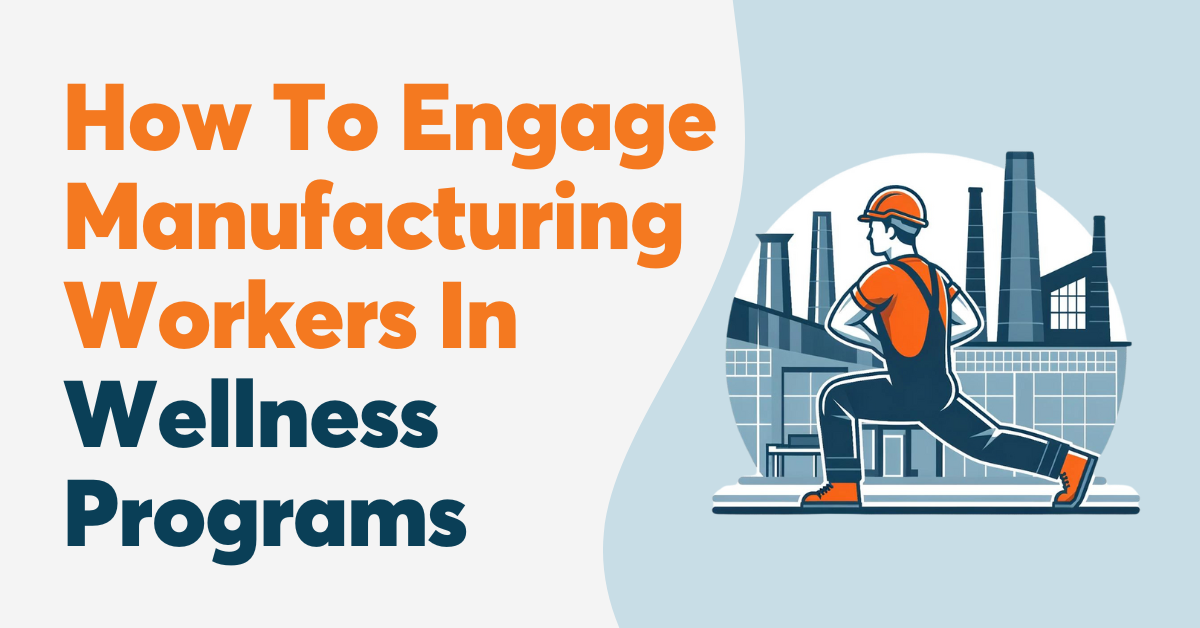In the manufacturing sector, where shift work, physically demanding tasks, and limited healthy lifestyle options are common, wellness programs can be transformative in improving employee well-being. Beyond the benefits for employees, wellness initiatives have been shown to reduce absenteeism, boost productivity, uplift morale, and reduce healthcare costs.
However, research indicates a noticeable gap in wellness program participation due to insufficient awareness and accessibility among manufacturing employees. Addressing these challenges requires a strategic approach tailored to the manufacturing environment.
Pressed for time? Here’s a quick summary…
- Relevance & accessibility: Tailor wellness activities to accommodate all shift schedules, integrate into daily routines, and resonate with the realities of manufacturing work.
- Supportive culture: Cultivate a wellness-focused environment from the top down, with leadership setting the example and initiatives like wellness champions amplifying support across the organization.
- Incentivize participation: Combining a tiered reward system with regular, small rewards encourages both immediate participation and sustained engagement.
- Variety & choice: Ensure wellness programs meet diverse employee needs and preferences, informed by direct feedback, ensuring initiatives are relevant to the workforce.
- Leverage technology: Develop a centralized platform for wellness challenges and send text message reminders to keep wellness accessible and top-of-mind for shift workers.
1. Make Programs Relevant & Accessible
To truly benefit manufacturing employees, wellness programs must be thoughtfully designed to fit into their unique work-life realities.
Flexibility For All Shifts
Given the varying shift schedules of manufacturing, wellness activities and resources should be available around the clock to accommodate everyone. This could involve:
- Offering on-demand classes for 24/7 accessibility
- Scheduling live wellness events (such as health fairs and workshops) at multiple times to cater to different shifts
Realistic Goals & Actions
Recognizing the challenges blue collar employees face in managing time for health, wellness initiatives should be practical and easily integrated into daily routines. This could include:
- Encouraging micro-workouts, designed to fit into short breaks, for on-the-job exercise
- Providing healthy meal prep guidance, acknowledging shift workers’ unique time constraints
Resonating Wellness Concepts

Blue collar wellness programs should be presented in a context that aligns with manufacturing workers’ real-life experiences, making them not just an option but a necessity for improved work and life quality. Examples include:
- Linking physical activity to injury prevention
- Framing mental health in terms of improving focus and workplace resilience
2. Build A Supportive Culture
Cultivating a health-first culture starts from leadership and spreads to the factory floor, where wellness is supported and celebrated to foster improvements in employee health and happiness.

Leadership Buy-In
When company leaders actively model healthy behaviors—such as through participation in wellness programs, sharing personal health journeys, or making healthier choices visible—they set a powerful example for all employees. Recognizing achievements and publicly supporting wellness initiatives are ways leaders can inspire a company-wide culture of health.
Buddy Systems & Team Challenges
Implement buddy systems or team challenges to foster a sense of accountability and camaraderie among workers. These initiatives encourage employees to support each other, share tips, and celebrate successes together. For example, team challenges that track collective steps or shared wellness goals not only promote healthy competition but also strengthen team bonds and make wellness a shared responsibility.
Wellness Champions
Wellness champions are employees who volunteer to support and promote wellness initiatives within their organization. They translate overarching goals into tangible, relatable actions that resonate with the workforce’s diverse needs. Companies that embrace wellness champions foster peer-to-peer support that enhances program effectiveness and relatability.
3. Incentivize Participation
Incentivizing participation is crucial for the success of wellness programs, especially in the industrial and manufacturing sectors where daily routines are rigorous and time is precious. By introducing holistic rewards, companies can spark interest and maintain engagement, ensuring that wellness becomes a valued part of employees’ lives.
Tiered Reward Systems
A tiered reward system can dramatically increase long-term engagement by setting clear, achievable milestones. The rewards in each tier can escalate in value to mirror the challenge and commitment required to reach higher levels.

Immediate, Small Rewards
Balancing long-term objectives with immediate, small rewards can sustain engagement between larger milestones. These could be simple tokens of recognition, like special badges, healthy snacks, or small gift cards for every completed activity or challenge.
4. Emphasize Variety & Choice
By offering a broad spectrum of choices and responding to employee feedback, blue collar wellness programs can become a more inclusive and embraced part of the company culture.
Employee Input In Program Selection
Gathering feedback through surveys or suggestion boxes allows employees to express their preferences and interests, ensuring that the programs are relevant and eagerly anticipated by the workforce.
Diverse Program Offerings
Offer a wide range of program options to accommodate varied needs, preferences, and abilities. This includes:
- Offering activities and resources that address multiple dimensions of wellness, such as stress management, nutrition education, and financial well-being
- Tailoring fitness classes to cater to different fitness levels, ensuring all capabilities are considered
- Providing a mix of low-impact exercise options (such as gentle yoga) for beginners or those seeking a relaxed workout, and high-impact sessions (such as HIIT workouts) for more vigorous activities
- Offering on-demand, on-site, and remote classes, allowing employees to choose a setting they find most comfortable
5. Leverage Technology
The integration of technology into wellness initiatives can help modernize and personalize these programs for manufacturing employees.

Fitness & Wellness Apps
Develop a centralized platform for wellness challenges to simplify participation and progress tracking. Ensure wearables and apps integrate with the wellness platform for a unified health tracking system.
Text Message Reminders & Health Tips
Sending out text message reminders and health tips is a simple yet powerful way to keep wellness top of mind for employees. These timely nudges can be particularly useful for shift workers who might not access company platforms regularly.
Virtual Support Groups
Establish virtual support groups to foster community among manufacturing employees. These groups offer a platform for sharing experiences, challenges, and successes, ensuring employees working various hours feel connected and supported in their wellness journeys.











